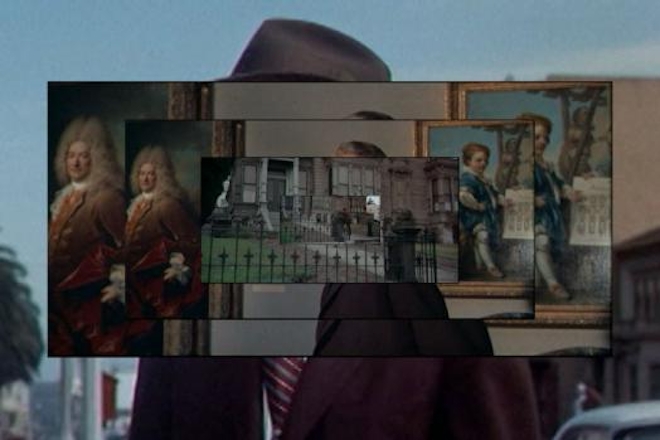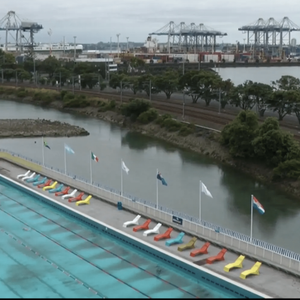Since the late 1970s Martin Rumsby has developed an extensive career as a filmmaker, writer, exhibitor and distributor in New Zealand and North America. On Friday Aug 30 at 2.45pm, Rumsby presents A Couple of Things, an illustrated lecture that finds cinematic futures in decayed and decomposing cinemas and in the reinvention of discarded cinematic genres. We took this opportunity to talk to Martin about his upcoming lecture, and his own fine filmmaking, examples of which can be seen on CIRCUIT here.
Mark Williams (MW): A Couple of Things proposes that we might find new cinematic futures in discarded genres. From what genre does Outsider Trading take it's cues? Why revive that genre now?
Martin Rumsby (MR): I believe that it may be widely held amongst media arts academics that the City Symphony represents a "modernist triumphant" point of view and has not really been a living cinematic genre since around the 1960s. This view of the city symphony sees mechanical cinema, industry, transport and communications as being interlinked and the city as a grand machine.
In the 1960s, however, a variation on this genre arose in the Third World. In this variation the city is defined by its people and communities reassert themselves. Examples include Hanoi, Martes 13 (1967) by the Cuban filmmaker Santiago Alvarez. In this film citizens unite against the mechanized warfare of an imperial power. Calcutta (Kolkatta) (1969) by Louis Malle depicts life in an overcrowded, depressed hangover of British colonialism.
More recently, feature films such as Traffic Signal (2007) by Madhur Bhandarkar and Do The Right Thing (1989) by Spike Lee depict small urban communities under pressure. In the experimental area there is also a type of film I call "downtown", such as Mike Hoolboom's TOM (2002) which I will be showing excerpts from in my presentation.
As for Outsider Trading, as far as I know there has never been a city symphony made in Auckland. So it seemed to me the time was right to make such a film in Auckland, from an outsider's point of view.
I am currently writing an article about city symphonic films for Millennium Film Journal.
MW: Some of the North American works you're showing rework older films, in the case of Gregg Biermann, Alfred Hitchcock's Vertigo. Given that Hitchcock's work has been pored over so much already, what makes Biermann's work so provocative?
MR: Gregg Biermann's film Labyrinthine (2010) is a digital restaging of Alfred Hitchcock's Vertigo (1958) as an architectural, algorithmic work. Here, narrative progression is replaced by a rigorous formal reconstruction of the picture and sound elements. I jokingly refer to it as a revisionist's view of American cinema. In reality, I regard Labyrinthine as a philosophically speculative work on notions of (cinematic) time and whether time is a continuous or discontinuous process.

Still from Labyrinthine (2010) Gregg Biermann
MW: You spent a long period of time living in North America, and your programme has a lot of North American work. What influence did living there have on your own filmmaking?
MR: The North American experience was completely transformational for me. So much great work has been made there, very little of which has made its way to New Zealand, even in the age of the internet. Artistic communities were also developed and supportive in a way unknown in New Zealand. There was an openness as well as an awareness of history and engagement in contemporary practice. I think the influence has been more around my viewing, thinking and writing about the work, trying to contextualise it.
My own filmmaking is still closely tied to documentary and landscape—be they rural, urban or mediascapes. I guess that American Sketchbook (2000) is the work that looks most like an American avant-garde film. For Dots (2003) and Browns Barbeque (2006) both reflect the profound influence of African American culture had on me and my questioning of ethnic representation and social subject matter in North American avant-garde film.
MW: One of the works you made whilst overseas, For Dots (2008) has a remarkable sense of intimacy; all of the people you film seem completely at ease with you and the camera. As an outsider, how did you get close to these people?
MR: When asked why African American people liked him Bill Clinton famously replied, "Because I like them." Dots, of course, was a great help and by my association with her I got to meet and was accepted by the street people. I enjoyed hanging out with them, their take on the world, and came to count them as my friends... all this over a period of ten years.
I think that Brown's Barbeque (2006) is my best film. The anthropologist Michael Goldsmith described it as a work of pure visual ethnography. It's of four generations of Dots' family having a Saturday afternoon barbeque. I only got one chance to shoot it and it looks the way it does because I recognized Dots' mannerisms in the women and girls present. It was emotionally draining to shoot it. I think of it as a work of pure love. As a result of all the time we spent together Dots and I are inextricably interlinked and remain very close friends. I was proud to have been a member of that community which someone once described as "the street gang I was running with."
MW: How has writing about the moving image influenced your film-making?
MR: My writing reflects my researches and thinking about film as art but not my filmmaking process. Indeed, I try to put all that stuff aside when thinking about my own filmmaking.
MW: You once wrote “...we only ever need have one original idea in our entire life. The importance is to act on that idea, seeing it through all possible conclusions...“ In your collective body of work do you think there is a single driving impulse?
MR: I think that I have an idea about community and the power of one which worked itself out in my film distribution and exhibition activities before I transferred it to my filmmaking. Judging by my lack of success in my recent film exhibition and filmmaking ventures I would have to say that this idea is not very popular. They would have been good ideas if they were sustainable but they weren't, so now I am finding myself coming up with new ideas—which is quite exciting. My long time interest in ethnography and the avant-garde is of increasing importance, the introduction of social subject matter into avant-garde cinema, and the relationship between documentary and experimental film are always interesting. Of course, I still love the intense subjectivity and mytho-poesis of Brakhage as well as Michael Snow's cool intellectualism, along with so much that came before and after. I am hopeful that I will make a meaningful contribution to this scene.
-a-film-by-Martin-Rumsby.jpeg)
